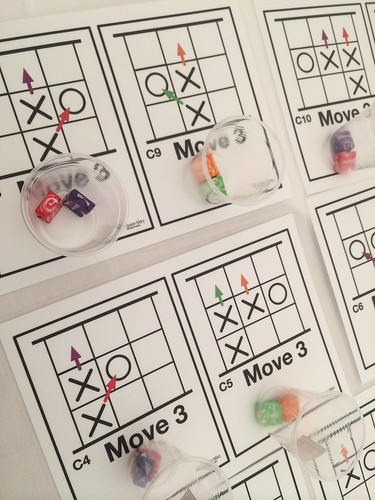Here are some Easter- and Spring-linked unplugged computing ideas.
Symmetrical Picture Puzzles: Easter
In symmetrical colour by number pictures you are only given the numbers for half the pictures. Use symmetry to work out the rest of the numbers and so the rest of the picture.
If you know something about the properties of a picture you can reconstruct the image despite storing fewer numbers! That is called image compression.
![]()
Easter chick design by Elisa Huen.
We have even more symmetrical picture puzzles here and lots of other pixel puzzles here.
Combine logical thinking with literacy.

Picasso introduced the idea of collage as art. These puzzles with an Easter theme combine art, maths and computing. You follow the instructions to make a collage picture from a collection of shapes. Cut out each of the shapes provided and place them in the right position on the gird. Learn about vector graphics and cartesian (x,y) coordinates.
Origami Instructions have a lot in common with programs. Algorithms are sequences of instructions that, to work, must be followed precisely and in the right sequence. Computers follow programs. Origamists (humans) follow origami instructions. Like a programming language the notation used in origami is standardised so that any origamist can follow the instructions from a sequence of diagrams written by anyone else.
 Print-out, colour-in, assemble and flex! This is a 3-faced hexaflexagon with the mildest of peril. Hidden inside the assembled flexagon is an Easter rabbit – can you find him?
Print-out, colour-in, assemble and flex! This is a 3-faced hexaflexagon with the mildest of peril. Hidden inside the assembled flexagon is an Easter rabbit – can you find him?
And if for you Easter is mainly about chocolate …
Make a working computer out of chocolate and learn about Alan Turing’s model of computation. Turing Machines were invented by Alan Turing before the first computers were created as a model of computation. It strips the idea of what computation is down to a very simple idea of a machine that manipulates symbols. Our symbols are made of chocolate and sweets.
Alan Michie invented one of the earliest machine learning machines out of beads and matchboxes. Ours of course is made out of sweets. It plays a game and the more you play it the better it gets as the more data it collects the more it learns. Eventually, it is invincible.
See also
Hallowe’en Puzzles
Christmas Computing






